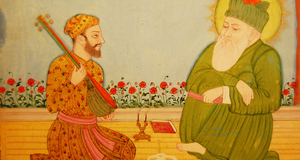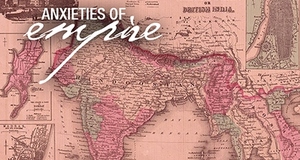From Jalaluddin to Akbar: Analyzing the Akbarid Notion of Kingship
By
2016, Vol. 8 No. 01 | pg. 4/4 | « VII: ConclusionWe have so far, seen how Jalaluddin Mohammad went from being just another Islamic monarch, a shadow of God, to being Akbar–the universal monarch, the perfect man, the manifestation of the divine light itself. However, as has been elucidated throughout the paper, Akbar’s greatness lay not in his supernatural abilities, or in his over-arching presence in Indian history by virtue of elevation to an unprecedented scale of Kingship. It is his very character and intelligence as a ruler to adapt to the needs of the empire that makes him stand out; the genius lay not in formulating an image of himself as the farr-i izadi, but in actually living the legend that he had Abul Fazl construct around him. Today, he is etched in the popular memory of all those who reside within the Riyasat-i Hindustan, as a ‘Great’ emperor.39 The populace and school students, in whose textbooks he features as lone-chapters in himself, as the man who made the Indian subcontinent united under one rule, remember him. His legendary status as a universal monarch was so strongly formalized by Abul Fazl that it still survives today. Perhaps the greatest testament to his image was the fact that upon his death, at least the town of Jaunpur went into mourning; shops were shut, businesses closed down, all the choolhas of the town were put out; life came to halt as all men and women mourned the passing of the Divine Light from this world.40 But, as historians, it is important to lift the veil of divinity and to look past the propaganda in Abul Fazl. In doing so, one has to turn to sources like Badauni41, and trace the counter-developments in the reign of the insan-i kamil. Perhaps, it is time that the myth of divinity was busted.It would be naïve, however, to say that there is nothing that was distinct about Akbar; to reduce him to a normal human being is probably a neo-liberal attempt at reading his achievements, which not only disregards a major historical fact–the fact that Akbar was, inarguably, the cornerstone of the cementing of the Mughals in Hindustan. It was only possible for Jahangir and Shah Jahan to expand the Riyasat because Akbar consolidated the position of the Mughal Emperor after the tumultuous reign of his father Humayun. If there is a lesson that is to be learnt from the Akbarid notion of kingship, whether it may be Akbar’s own conception or the fabrication of Abul Fazl, it is the dual notions of mohobbat-i kul42 and adl43 reigning supreme over all beings in society. Thus, Akbar’s legacy lies not in the speculative court politics, but in his world vision, his global outlook and his striving for a society where all beings love each other as equals; undermining all previous identities and ties of loyalty. ReferencesAli Anooshahr ‘Mughal Historians and the Memory of the Islamic Conquest of India’ The Indian Economic and Social History Review Vol. 43, No. 3 (2006) pp. 275-300. Iqtidar Alam Khan ‘Akbar’s Personality Traits and World Outlook: A Critical Reappraisal’ (1997) Bhargava, Meena (ed.) Exploring Medieval India: Sixteenth to Eighteenth Centuries: Politics, Economy, Religion (2010, Orient Blackswan, New Delhi), pp. 353-369. John F. Richards ‘The Formulation of Imperial Authority Under Akbar and Jahangir’ (1998), Meena Bhargava (ed.) Exploring Medieval India: Sixteenth to Eighteenth Centuries: Politics, Economy, Religion (2010, Orient Blackswan, New Delhi), pp. 181-224. Lisa Balbanlilar ‘Lords of the Auspicious Conjunctions: The Turco-Mongol Imperial Identity on the Subcontinent’ in Journal of World History, Vol. 18, No. 1 (March, 2007), pp. 1-39. Stephen Frederic Dale ‘The Autobiographical Writings of Zahir al-Din Muhammad Babur, 1483-1530’ in International Journal of Middle East Studies, Vol. 22. No. 1 (Feb., 1990), pp. 37-58. Notes of Prof. Aniket Chhetry’s guest lectures at Hans Raj College, Delhi University (2015). Endnotes1.) As the logic goes, anybody who is supposed to have centralized the politics of the subcontinent–or in fact any other place–is placed amongst the Greats in history and popular memory. 2.) For the sake of convenience, I use “Akbar” instead of “Jalaluddin” in the paper for all references to him. Also, diacritical marks are avoided throughout the paper, so as to make easy reading for the lay reader. 3.) Richards, John F. ‘The Formulation of Imperial Authority Under Akbar and Jahangir’ (1998), Bhargava, Meena (ed.) Exploring Medieval India: Sixteenth to Eighteenth Centuries: Politics, Economy, Religion (2010, Orient Blackswan, New Delhi). Richards is borrowing these ideas from Iqtadar Alam Khan (1968) and S.A.A. Rizvi (1975). 4.) Both these factions were constant rivals and thus, not enough for Akbar to depend upon. This created the need for newer ethnicities to be incorporated into the nobility viz. Shaykhzadas, Pirzadas, Rajputs, other Hindu rulers and so on. Thus, he was not as liberal as he seems to be. 5.) Dale, Stephen Frederic ‘The Autobiographical Writings of Zahir al-Din Muhammad Babur, 1483-1530’ in International Journal of Middle East Studies, Vol. 22. No. 1 (Feb., 1990), pp. 37-58. 6.) Ibid. pp. 50-51. The example of Babur’s description of women is of particular importance to Dale, as it exhibits almost an anomaly in pre-modern Islamic literature. This, he characterizes as a distinguishing feature of the Steppe Humanist element in the Baburnama. Some historians, though, argue that this characteristic comes as a symptom of the nascent empire building of Babur’s polity. 7.) Ibid. pp. 51. 8.) Evidenced in the Akhlaq-i Humayuni. 9.) Balbanlilar, Lisa ‘Lords of the Auspicious Conjunctions: The Turco-Mongol Imperial Identity on the Subcontinent’ in Journal of World History, Vol. 18, No. 1 (March, 2007), pp. 1-39. 10.) Especially because literally all of the court’s papers and documents moved along with all the people present in the court as well as the harem. 11.) Richards, John F. ‘The Formulation of Imperial Authority Under Akbar and Jahangir’ (1998), Bhargava, Meena (ed.) Exploring Medieval India: Sixteenth to Eighteenth Centuries: Politics, Economy, Religion (2010, Orient Blackswan, New Delhi). pp. 186. 12.) These include Chengiz Khan, Timur, Babur, Humayun and all others belonging to the Chengizi-Timurid clan. 13.) Richards, John F. ‘The Formulation of Imperial Authority Under Akbar and Jahangir’ (1998), Bhargava, Meena (ed.) Exploring Medieval India: Sixteenth to Eighteenth Centuries: Politics, Economy, Religion (2010, Orient Blackswan, New Delhi). pp. 199-204. 14.) This was a status claimed by all Islamic rulers before and after Akbar. All were shadows of god; there was only one light of god himself. 15.) Two incidents of fits are termed by Abul Fazl as cases of mystic episodes. These forwarded the claims to spiritual mastership as Akbar claimed to have seen God himself during these episodes. 16.) This capital itself had an important role to play in forming of the authority of Akbar, as J.F. Richards highlights. 17.) Richards, John F. ‘The Formulation of Imperial Authority Under Akbar and Jahangir’ (1998), Bhargava, Meena (ed.) Exploring Medieval India: Sixteenth to Eighteenth Centuries: Politics, Economy, Religion (2010, Orient Blackswan, New Delhi). pp. 214-215. 18.) Ibid. pp. 209. 19.) Ibid. 20.) Sijdah is a Persian court ritual of the Sassanids. It involves full prostration of the individual at the emperor’s feet; the latter would then hold the person up. Under the Din-i elahi, upon raising the inductee, Akbar would offer the disciple a “new turban…a symbolic representation of the sun and, a tiny portrait of Akbar to wear upon his turban.” (Richards, 1998) 21.) In return for peshkash or nazrana, which the disciple was to give to the Emperor upon each meeting or visit. 22.) Richards, John F. ‘The Formulation of Imperial Authority Under Akbar and Jahangir’ (1998), Bhargava, Meena (ed.) Exploring Medieval India: Sixteenth to Eighteenth Centuries: Politics, Economy, Religion (2010, Orient Blackswan, New Delhi). pp. 216-217. Richards also traces how the practice of escheat with regard to treasuries, mansion, armouries, stables and other properties of the imperial disciples helped develop the notions of khanazaadgi in Akbar’s period. 23.) This Akbar borrows from the Nasiri ethic found in the Akhlaq-i Nasiri, written by Nasiruddin Tusi. 24.) However, it was to be based on mutual consent of both the man and the woman. This seems a skewed notion to have existed among all this patriarchy. Thus, one may conclude that this was just a formality on paper. In practice, mutual consent was only manufactured. 25.) Khan, Iqtidar Alam ‘Akbar’s Personality Traits and World Outlook: A Critical Reappraisal’ (1997) Bhargava, Meena (ed.) Exploring Medieval India: Sixteenth to Eighteenth Centuries: Politics, Economy, Religion (2010, Orient Blackswan, New Delhi), pp. 364. 26.) Ibid. pp. 362. 27.) Ibid. pp. 357 28.) Badauni called this place “shaitanpuri” or “Devil’s Town.” 29.) In his defence, Akbar did pull the Jaziya back a few years later. 30.) Khan, Iqtidar Alam ‘Akbar’s Personality Traits and World Outlook: A Critical Reappraisal’ (1997) Bhargava, Meena (ed.) Exploring Medieval India: Sixteenth to Eighteenth Centuries: Politics, Economy, Religion (2010, Orient Blackswan, New Delhi), pp. 362 31.) He was so controversial that Jahangir had all his family arrested upon the publication of his tawarikh. 32.) It is interesting to note that he praised Mahmud of Ghazni for being the exact opposite of this. See Anooshahr, Ali ‘Mughal Historians and the Memory of the Islamic Conquest of India’ The Indian Economic and Social History Review Vol. 43, No. 3 (2006) pp. 275-300 33.) Ibid. pp. 288-291 and 293. He, in one go, criticizes Timur, Qutubuddin Aibek, Iltutmish, Alauddin Khilji, Mohammad bin Tughlaq and ultimately Babur, Humayun and Akbar. 34.) Iqtidar Alam Khan finds that this evidence is also in Arif Qandahari’s Tarikh-i Akbari. See Khan, Iqtidar Alam ‘Akbar’s Personality Traits and World Outlook: A Critical Reappraisal’ (1997) Bhargava, Meena (ed.) Exploring Medieval India: Sixteenth to Eighteenth Centuries: Politics, Economy, Religion (2010, Orient Blackswan, New Delhi), pp. 357. 35.) The only contact was to be through nurses. These nurses were instructed not to make conversation in presence of these children. Their tasks were mainly those of maintaining hygiene and providing food to the children. 36.) Ibid. pp 358. 37.) Especially in Badauni’s Muntakhab ul Tawarikh, from which he quotes extensively. 38.) Along with other historians of Akbar’s reign, he was critical in his analysis of the insan-i kamil. 39.) Paradoxically, he is referred to as “Akbar the Great”; which is ignorant of the fact that “Akbar” itself translates to “great.” 40.) This particular case is found described greatly in the Jaina merchant Banarasidas’s Ardhakathanaka. 41.) Although, Badauni is the other extreme of the propaganda, offering a polar opposite view in his hypercriticism. Undoubtedly, he too is biased. 42.) Mohabbat-i kul is the direct antecedent of sulh-i kul. It literally means Love between all people of the community. 43.) Adl literally means justice. Akbar looked to formulate a world where adl would pervade for all humans equally. Suggested Reading from Inquiries Journal
Inquiries Journal provides undergraduate and graduate students around the world a platform for the wide dissemination of academic work over a range of core disciplines. Representing the work of students from hundreds of institutions around the globe, Inquiries Journal's large database of academic articles is completely free. Learn more | Blog | Submit Latest in History |


















